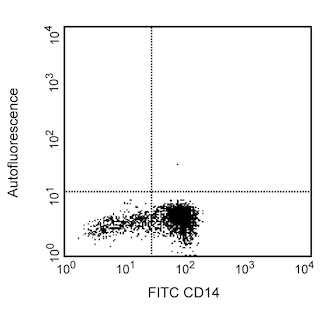-
Your selected country is
Middle East / Africa
- Change country/language
Old Browser
This page has been recently translated and is available in French now.
Looks like you're visiting us from {countryName}.
Would you like to stay on the current country site or be switched to your country?


.png)

Multiparameter flow cytometric analysis of CD298 expression on human peripheral blood leucocyte populations. Human peripheral blood cells were stained with either Mouse IgG2a, κ Isotype Control (Cat No. 553457, Left Plot) or PE Mouse Anti-Human CD298 antibody (Cat No. 566792, Right Plot). Erythrocytes were lysed with BD Pharm Lyse™ Lysing Buffer (Cat. No. 555899). The pseudocolor density plot showing the correlated expression of CD298 (or Ig Isotype control staining) versus side light-scatter (SSC-A) signals was derived from gated events with the forward and side-light scatter characteristics of viable leucocyte populations. Flow cytometry and data analysis were performed using a BD FACSCelesta™ Cell Analyzer System and FlowJo™ software.
.png)

BD Pharmingen™ PE Mouse Anti-Human CD298
.png)
Regulatory Status Legend
Any use of products other than the permitted use without the express written authorization of Becton, Dickinson and Company is strictly prohibited.
Preparation And Storage
Product Notices
- This reagent has been pre-diluted for use at the recommended Volume per Test. We typically use 1 × 10^6 cells in a 100-µl experimental sample (a test).
- An isotype control should be used at the same concentration as the antibody of interest.
- Caution: Sodium azide yields highly toxic hydrazoic acid under acidic conditions. Dilute azide compounds in running water before discarding to avoid accumulation of potentially explosive deposits in plumbing.
- Source of all serum proteins is from USDA inspected abattoirs located in the United States.
- For fluorochrome spectra and suitable instrument settings, please refer to our Multicolor Flow Cytometry web page at www.bdbiosciences.com/colors.
- Please refer to http://regdocs.bd.com to access safety data sheets (SDS).
- Please refer to www.bdbiosciences.com/us/s/resources for technical protocols.
Companion Products





The P-3E10 monoclonal antibody specifically recognizes CD298, the β3 subunit of the Na+/K+ ATPase (Sodium/potassium-transporting ATPase subunit beta-3). CD298 is a ~45-55 kDa single-pass, type II membrane protein that is encoded by ATP1B3 (ATPase Na+/K+ transporting subunit beta 3) which belongs to the P-type ATPases superfamily. CD298 is widely expressed on lymphocytes, monocytes, granulocytes, platelets, and on other hematopoietic and nonhematopoietic cells and cell lines. The Na+/K+ ATPase is an integral membrane protein complex with enzymatic activity that mediates the active transport and exchange of sodium and potassium ions across the plasma membrane. This complex is composed of α and β subunits. The α subunit is a 10-membrane-spanning, catalytic protein that contains binding sites for Na +, K + and ATP. The α subunits are associated with the smaller, regulatory glycoprotein β subunits. Upon ATP hydrolysis, the Na+/K+ ATPase transports Na+ ions out of the cell in exchange for K+ ions that are transported in. This establishes a transmembrane electrochemical gradient that is essential for osmoregulation and for the transport of various nutrients and other molecules by cells. The P-3E10 antibody can reportedly inhibit the activation and proliferation of T cells and B cells.

Development References (6)
-
Chiampanichayakul S, Khunkaewla P, Pata S, Kasinrerk W. Na, K ATPase beta3 subunit (CD298): association with alpha subunit and expression on peripheral blood cells.. Tissue Antigens. 2006; 68(6):509-17. (Clone-specific: Flow cytometry). View Reference
-
Chiampanichayakul S, Szekeres A, Khunkaewla P, et al. Engagement of Na,K-ATPase beta3 subunit by a specific mAb suppresses T and B lymphocyte activation.. Int Immunol. 2002; 14(12):1407-14. (Immunogen: Flow cytometry, Functional assay, Inhibition). View Reference
-
Chruewkamlow N, Pata S, Mahasongkram K, Laopajon W, Kasinrerk W, Chiampanichayakul S. β3 subunit of Na,K ATPase regulates T cell activation with no involvement of Na,K ATPase activity.. Immunobiology. 2015; 220(5):634-40. (Clone-specific: Functional assay, Inhibition). View Reference
-
Horváth O, Drbel K, Angelisová P, Hilgert I, Horejsí V. Non-lineage antigens: section report. Cell Immunol. 2005; 236(1-2):42-47. (Clone-specific). View Reference
-
Swart B, Salganik MP, Wand MP, et al. The HLDA8 blind panel: findings and conclusions. J Immunol Methods. 2005; 305(1):75-83. (Clone-specific). View Reference
-
Takheaw N, Laopajon W, Surinkaew S, Khummuang S, Pata S, Kasinrerk W. Ligation of Na, K ATPase beta3 subunit on monocytes by a specific monoclonal antibody mediates T cell hypofunction. PLoS One. 2018; 13(6):e0199717. (Clone-specific: Flow cytometry, Functional assay, Inhibition). View Reference
Please refer to Support Documents for Quality Certificates
Global - Refer to manufacturer's instructions for use and related User Manuals and Technical data sheets before using this products as described
Comparisons, where applicable, are made against older BD Technology, manual methods or are general performance claims. Comparisons are not made against non-BD technologies, unless otherwise noted.
For Research Use Only. Not for use in diagnostic or therapeutic procedures.
Report a Site Issue
This form is intended to help us improve our website experience. For other support, please visit our Contact Us page.